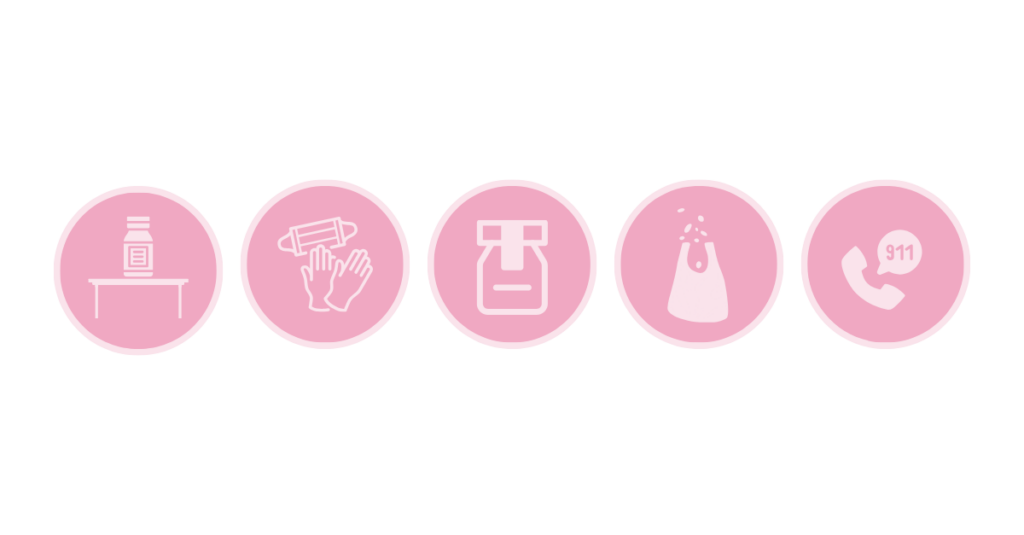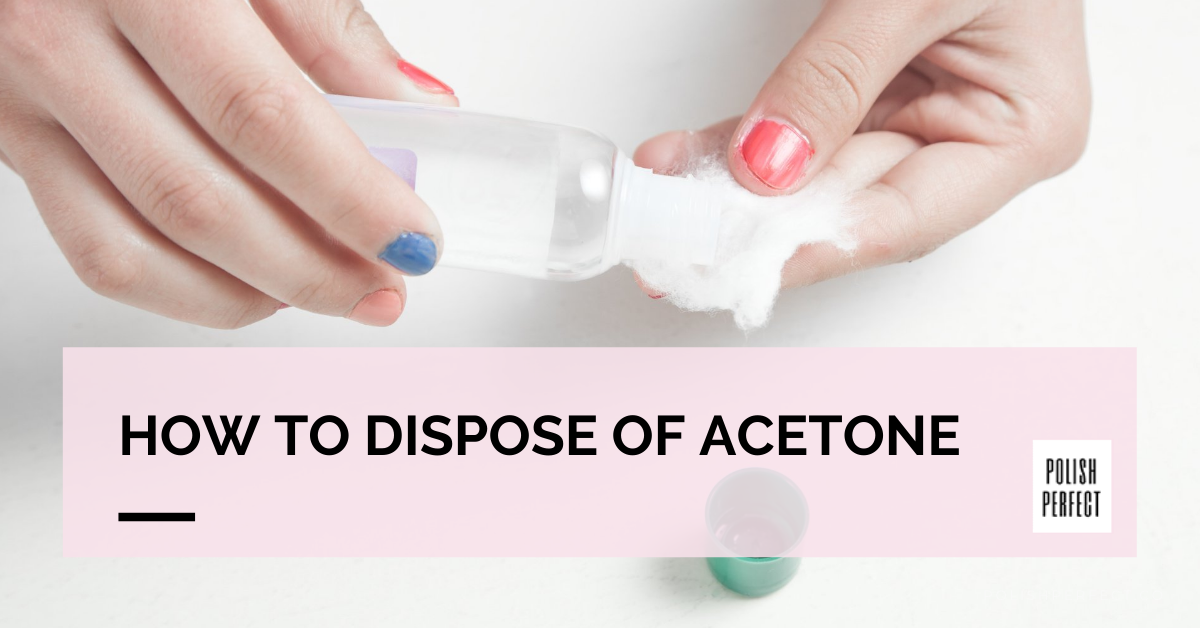So, you just finished your nails. They look beautiful. Now that they have finished drying, it’s time to clean up.
As someone passionate about both beauty and the environment, it’s essential for me to address a common question:
How to dispose of acetone correctly?
It’s not just about the beauty on the outside; it’s also about the care we take after. Should you just throw it in the trash?
The answer is NO.
Is Acetone a Hazardous Material?
Most nail polish remover brands use acetone in their formulas, which puts nail polish remover in the hazardous chemicals category.
In fact, acetone is commonly used by mechanics as a degreaser to help remove adhesive from vinyl or resin.
Because acetone is a harsh chemical and is extremely flammable, there is a right and wrong way to dispose of it.
Much like oil, glass, and other hazardous substances that must follow special waste instructions, acetone is also on the list! [1]
So, what should you do?
Read on for some tips and steps on how to dispose of acetone—the RIGHT way!
What You Will Need To Dispose Acetone

Because acetone is extremely flammable and can cause damage when inhaled or exposed to skin for long periods of time, acetone hazards are nothing to mess around with.
Therefore, proper handling, use, and disposal are required not only for salons but also for individuals.
So, what items do you need to dispose of acetone properly and safely?
Here is a list:
- A sealed metal or fireproof container
- Rubber or latex gloves
- A large garbage bag
- A mask (if necessary)
If you own or operate a salon and dispose of large amounts of acetone each day, then be sure to check with your local fire department for instructions on how to dispose of acetone.
Some fire departments require that businesses and salons dispose of acetone in a fireproof container.
Depending on the state or region in which you operate, you may be required to take waste acetone to a local hazardous waste treatment center or recycling center to properly dispose of acetone.
Do’s And Don’ts Of Acetone Disposal
Acetone can be considered a hazardous chemical as it can cause health and environmental hazards if not properly disposed of.
Here are the things that you have you keep in mind with regards to acetone disposal.
Do’s
#1 – Put them in a separate garbage bag
#2 – Separate empty acetone containers from other recyclable materials that you’ll throw away
#3 – Wash your hands carefully after acetone disposal
Don’ts
#1 – Don’t expose other waste materials to acetone or waste with acetone
#2 – Don’t pour acetone on the toilet or drain
#3 – Don’t dispose of them just anywhere, especially in hot places or where there is open flame
Steps on How to Dispose of Acetone

Disposing of acetone is relatively easy when you have the items above on hand and when following these step-by-step instructions.
1. Work with Acetone on a Hard Surface
Always pour and use acetone over a flat table or counter. It’s just safer that way. If any spills, wiping it up is a snap on a hard surface!
Did you know? Many nail pros use a cool nail table called a manicurist’s table or even a pedicure chair tub when they’re working with acetone.
But hey, if you’re relaxing on your couch, doing your nails, and watching TV, be extra careful! Spilling acetone there could really mess up your comfy spots. If a lot spills, you might even have to get rid of that couch or rug. Yikes!
A big heads-up! Breathing in acetone for too long isn’t great for you. Always make sure the room you’re in has plenty of fresh air. Nail salons have this down with great ventilation. If you’re at home, always make sure to open up a window or door. Fresh air for the win!
2. Wear Gloves (and a Mask)
Always slip on rubber or latex gloves when using or tossing out acetone. A little bit of acetone is okay for a short time, but if you’re handling a lot, you really need those gloves on!
Nail pros, I know you might feel like taking off your gloves after doing someone’s nails. But keep them on, especially when cleaning up and throwing away acetone. And hey, a mask is a good idea too!
Allergic to latex?
No worries! You can wear those rubber cleaning gloves. They’re thick and will keep your hands safe from acetone.
3. Use a Sealed Metal Container (with a Secure Lid)
Storing acetone the right way is super important. While it might seem okay to keep acetone in the plastic bottles you buy them in, they can cause some messy spills.
These spills could be bad news for everyone, especially kiddos and pets.
Protip: Pour your acetone into a metal container that has a tight-sealing lid. This way, it stays safe and sound.
When you’re done using acetone, especially in salons, make sure to put the leftover liquid in a sealed metal container. This makes it easy to get rid of later.
Big salons sometimes use a lot of acetone. So they might need a special, super-safe, fireproof container.
Some local fire departments or special centers might provide these containers. In some places, there are even pros who come and pick up the used acetone every day! But this can change depending on where you live.
Also, remember to have the right permits to use, store, and toss out acetone safely. For more info, you can check out the Environmental Protection Agency. They know their stuff!
4. Throw Used Products In A Garbage Bag
For DIY-at-home individuals, it is relatively safe to dispose of your used products with acetone in the garbage bin.
This is because only a small amount of acetone is typically used, and the risks of fire or injury are lower.
However, this is only acceptable for small amounts only.
For example, if you used tissue, a few cotton balls, or a paper towel to clean up excess acetone or remove nail polish, be sure to allow sufficient time for the products to dry prior to throwing them in a garbage bag.
It’s important to throw away used acetone paper products in a separate garbage bag. Do not throw away used paper products soaked with acetone in with the rest of your trash.
Again, acetone is incredibly flammable, and it can ignite even from a distance. So, it is possible for other products in your trash can to catch fire if they come in contact with acetone.
Do yourself a favor and throw your used paper products in a separate garbage bag and throw it away separately.
If you are really worried, you can also take your garbage bag to a local recycling center.
You can also create your own sealed container with a trash bag. This will ensure that your paper products are protected and away from other potentially flammable items in your trash.
You can also opt to use non-acetone nail polish remover products instead to avoid having to deal with the hassle of disposing of acetone properly.
5. What to Do in an Emergency
If you or a client accidentally spills, ingests, or inhales a large amount of acetone, then seek immediate medical attention.
Call 9-1-1 or also call the Poison Control hotline for more information on what to do if a dangerous amount of acetone is exposed to the skin, the eyes, or ingested or inhaled.
If a child or pet is exposed to acetone, and you aren’t sure as to the amount, take caution and seek immediate medical or veterinary attention.
Of course, accidents can happen. However, storing acetone away in a concealed container or high on a shelf will prevent spills and curious pets and children from investigating and playing with it.
Safety Precautions for Acetone Disposal
If you’re a nail technician, then you know that acetone is a staple in the industry. It’s the go-to solution for removing nail polish and cleaning nail brushes.
Here is a lowdown on acetone disposal and some important safety precautions you need to follow.
Can You Pour Acetone Outside?
Let’s start with the great outdoors. Can you simply pour acetone outside and let nature take care of it?
Well, not so fast. Acetone is a volatile solvent, which can easily evaporate and release harmful fumes into the air.
Not only can inhaling these fumes be dangerous for you, but it can also harm the environment. So, pouring acetone outside is a big NO-NO.
Instead, follow the proper disposal methods I’m about to share with you.
Can You Pour Acetone Down the Drain?
Now, before you start pouring acetone down the drain, let me give you a reality check.
Acetone is a powerful solvent that can wreak havoc on your plumbing system. It can corrode pipes and cause blockages, leading to costly repairs.
So, unless you want to be knee-deep in plumber’s bills, avoid pouring acetone down the drain. It’s just not worth the risk.
Can You Flush Acetone Down the Toilet?
Okay, so pouring acetone down the drain is off the table. But what about the toilet? Can you give it a quick flush and be done with it?
Sorry to burst your bubble, but flushing acetone down the toilet is a big fat no. Just like with the drain, acetone can damage your plumbing system and cause all sorts of headaches.
So, let’s leave the toilet out of the acetone disposal equation.
Can You Leave Acetone to Evaporate?
You might be thinking, “Hey, if I can’t pour acetone down the drain or flush it down the toilet, can I just leave it out and let it evaporate?”
Well, not exactly. While acetone does evaporate quickly, leaving it out in the open can be dangerous. Remember those harmful fumes I mentioned earlier?
Yeah, they’re still a problem. Plus, if you leave acetone in an open container, it can accidentally ignite if exposed to a spark or flame.
And trust me, you don’t want to be a part of that fiery show. So, let’s explore safer disposal options, shall we?
Is Acetone Reusable?
Now, here’s a question that might have crossed your mind. Can you reuse acetone? After all, it seems like a waste to throw it away after just one use.
Well, the good news is that acetone can be reused, but with caution. If you’re using acetone to remove nail polish, you can strain it through a coffee filter to remove any nail polish residue.
Then, you can store it in a tightly sealed glass container for future use. Just make sure to label it clearly, so you don’t accidentally mistake it for your morning coffee!
Can I Put Acetone in a Plastic Container?
Speaking of containers, you might be wondering if it’s safe to store acetone in a plastic container. Well, acetone is a strong solvent that can dissolve certain types of plastic.
So, it’s best to avoid storing it in plastic containers, especially if you’re planning on reusing it. Instead, opt for glass containers or metal cans that are resistant to acetone. Safety first, my friends!
Can You Recycle Acetone?
Now, let’s talk about recycling acetone. Unfortunately, acetone cannot be recycled through regular recycling programs.
Due to its hazardous nature, it requires special handling and disposal methods.
However, there are companies that specialize in hazardous waste disposal, and they can properly dispose of your acetone for you.
Just do a quick search online for hazardous waste disposal services in your area, and they’ll take care of it for you.
Final Thoughts
When it comes to acetone disposal, it’s essential to prioritize safety and follow the correct procedures.
For me, emphasizing the safe disposal of acetone wasn’t just about sharing knowledge—it’s a reflection of my commitment to both beauty and the environment. I believe it should matter to you too.
Did you find this article useful?
Your feedback is invaluable; please share your thoughts in the comments. If you found this guide beneficial, spread the word and share it.



